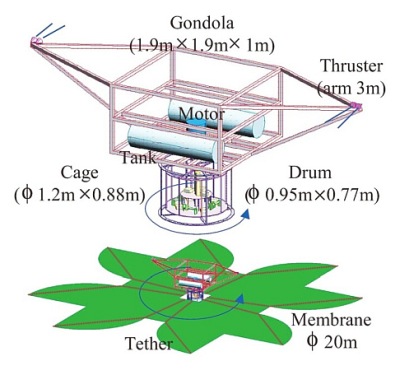Purpose of the flight and payload description
This balloon mission was part of the developmental effort for IKAROS a Japanese spacecraft launched in May 2010, that was the first to successfully use a SOLAR SAIL at some distance from Earth.
Solar sails use large membrane mirrors instead of rocket engines for propulsion. The kinetic force is obtained from light particles (photons) emitted by the Sun. When photons reflects off the surface of the solar sail, their energy and momentum are transferred to the sail. This gives the sail a "push" that accelerates it through space. Although radiation pressure is small and decreases by the square of the distance from the sun, the great advantage of this kind of vehicles is that they require no fuel. While the science of solar sails is well-proven, the technology to manage large solar sails is not, especially regarding the unfolding in space of these thin and delicate structures.
The Kawaguchi Laboratory drove during the 2000's decade a research effort to develop such a vehicle specially focusing in craft's membrane unfolding and steering mechanisms both dynamic and cuasi-static.
THE BALLOON TEST SYSTEM
As part of the studies of the deployment of the sail in space, it was planned to carry out a test using a balloon in the stratosphere to simulate as accurately as possible the conditions of deployment with a very low drag coefficient due to the thin air. In the upper left image we can see an scheme of the gondola (click for more details including the deployment sequence).
The deployment system was suspended from the balloon via a swivel. A video camera and radio unit was fixed on the main gondola which was located 28 meters above the so-called "sub-gondola" which contained the deployment system.
The deployment system was fixed under the sub-gondola and was based on a drum structure. The shape of the drum was octagonal cylinder with a height of 0.64 meters. The sub-gondola had two pairs of thrusters whose arm length was 3.5 meters, which rotated the experimentation system during the mission. A pair of thrusters were counter-clockwise and the another clockwise which accelerated and decelerated the spin, respectively. To control the spin rate, two gyro sensors were mounted on the structure. Two carbon fiber�reinforced plastic tanks (each one 150 liters) were located inside the sub-gondola to feed the thrusters. A camera located in one side of the sub-gondola showed the deployment sequence in real time to the ground control.
The membrane of the test sail was made of Polyethylene Terephthalate (PET) film, square-shaped with folding lines having a diagonal length of 20 meters. Four tether lines were wriggled on the membrane for controlling deployment speed. The membrane -which was initially rolled up around the drum- received centrifugal force to be deployed. Small masses were added on the four corners of the membrane to help the deployment by increasing the centrifugal force.
DEPLOYMENT SEQUENCE
After the balloon reached float altitude, the experiment was powered on. First phase was to acquire a spin up to 24 revolutions per minute (rpm), after which the relative rotation motor control start and the first stage deployment was achieved. Once this phase is completed a spin rate of 15 rpm is maintained to study the dynamics of cross shaped membrane. After that, the spin is increased again up to 21 rpm and the guide bars are released starting the second deployment stage. A spin rate of 15 rpm is maintained to allow the study the dynamics of the full expanded membrane.
Once completed this phase, top and side cameras are turned off, the experiment system is powered off and the payload is separated from the balloon for a safe splashdown in the Ocean.
Details of the balloon flight
Balloon launched on: 5/29/2005
Launch site: Sanriku Balloon Center, Iwate, Japan
Balloon launched by: Institute of Space and Astronautical Science (ISAS) / Japan Aerospace Exploration Agency (JAXA)
Balloon manufacturer/size/composition: Zero Pressure Balloon model B200 200.000 M3
Flight identification number: B200-5
End of flight (L for landing time, W for last contact, otherwise termination time): 5/29/2005
Balloon flight duration (F: time at float only, otherwise total flight time in d:days / h:hours or m:minutes - ): 5 h 7 m
External references
- SOLAR SAIL website Kawaguchi Laboratory (via Archive.Org)
- Ballooning activities in Japan Advances in Space Research 42 (2008) 1619
- Dynamics of large membrane for solar sail-craft ASME 2007 International Design Engineering Technical Conferences and Computers and Information in Engineering Conference, September 4-7, 2007, Las Vegas, Nevada, USA
2682If you consider this website interesting or useful, you can help me to keep it up and running with a small donation to cover the operational costs. Just the equivalent of the price of a cup of coffee helps a lot.


